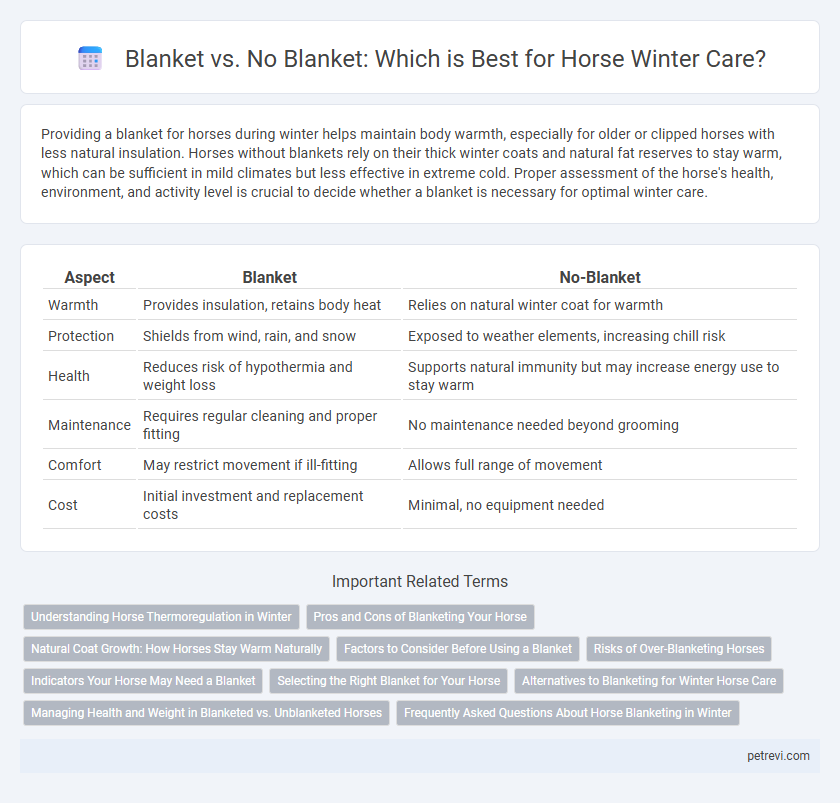Providing a blanket for horses during winter helps maintain body warmth, especially for older or clipped horses with less natural insulation. Horses without blankets rely on their thick winter coats and natural fat reserves to stay warm, which can be sufficient in mild climates but less effective in extreme cold. Proper assessment of the horse's health, environment, and activity level is crucial to decide whether a blanket is necessary for optimal winter care.
Table of Comparison
| Aspect | Blanket | No-Blanket |
|---|---|---|
| Warmth | Provides insulation, retains body heat | Relies on natural winter coat for warmth |
| Protection | Shields from wind, rain, and snow | Exposed to weather elements, increasing chill risk |
| Health | Reduces risk of hypothermia and weight loss | Supports natural immunity but may increase energy use to stay warm |
| Maintenance | Requires regular cleaning and proper fitting | No maintenance needed beyond grooming |
| Comfort | May restrict movement if ill-fitting | Allows full range of movement |
| Cost | Initial investment and replacement costs | Minimal, no equipment needed |
Understanding Horse Thermoregulation in Winter
Horse thermoregulation in winter relies on their natural ability to generate and conserve heat through thickened winter coats and fluffing their hair to trap air. Using blankets can aid in maintaining body temperature for older, clipped, or thin-skinned horses but may inhibit natural heat production if overused on healthy, unblanketed horses. Proper assessment of individual horse needs and environmental conditions ensures effective winter care without compromising thermoregulation mechanisms.
Pros and Cons of Blanketing Your Horse
Blanketing a horse in winter helps maintain body heat and prevent weight loss, especially for older or clipped horses. However, blankets can cause overheating, skin irritation, and restrict natural coat growth if used improperly. Choosing to blanket depends on your horse's health, coat condition, shelter availability, and climatic severity during winter.
Natural Coat Growth: How Horses Stay Warm Naturally
Horses develop a thicker winter coat through natural hair growth that provides effective insulation by trapping air close to their skin, which helps maintain body heat in cold weather. This natural adaptation allows many horses to stay warm without the need for a blanket, especially when they have adequate shelter and access to food. However, blankets may be beneficial for older or clipped horses whose natural coat is insufficient for extreme cold conditions.
Factors to Consider Before Using a Blanket
Assessing a horse's coat thickness, age, and health is vital before deciding on winter blanketing, as mature horses with thick winter coats may not require additional warmth. Environmental factors such as ambient temperature, wind chill, and shelter availability influence whether a blanket provides necessary protection against hypothermia and muscle stiffness. Monitoring the horse's behavior and physical condition regularly helps determine if blanketing supports optimal comfort and prevents cold-related stress injuries.
Risks of Over-Blanketing Horses
Over-blanketing horses during winter can lead to overheating, excessive sweating, and skin infections, which compromise their natural thermoregulation and coat condition. Heavy blankets inhibit the horse's ability to adjust its body temperature, potentially causing dehydration and respiratory issues due to trapped moisture. Proper assessment of weather conditions and the horse's individual needs is essential to prevent health risks associated with over-blanketing.
Indicators Your Horse May Need a Blanket
Signs your horse may need a winter blanket include a consistent drop in body temperature below 99degF, visible shivering, and a dull or patchy coat indicating an inability to maintain warmth naturally. Horses with thin body condition scores under 4, older age above 20 years, or those clipped for shows often require additional insulation to prevent weight loss and stress. Monitoring behavioral changes such as reluctance to move or seeking shelter more frequently also signals the need for protective blanketing during cold weather.
Selecting the Right Blanket for Your Horse
Selecting the right blanket for your horse involves assessing factors such as coat thickness, age, health, and climate conditions during winter. Horses with thinner coats, older age, or compromised health typically benefit from insulated, waterproof turnout blankets rated between 200g to 400g fill weight. Proper measurements of the horse's height and length ensure the blanket fits securely, preventing cold air entry and maximizing warmth retention throughout the colder months.
Alternatives to Blanketing for Winter Horse Care
Providing adequate shelter and using natural insulation such as thick winter coats are effective alternatives to blanketing for horse winter care. Ensuring access to windbreaks, dry bedding, and sufficient high-quality forage supports horses' thermoregulation during cold months. Regular grooming to maintain a healthy coat and monitoring hydration levels further enhance a horse's ability to stay warm without the need for blankets.
Managing Health and Weight in Blanketed vs. Unblanketed Horses
Blanketed horses often maintain body condition more effectively in winter by conserving energy typically used for natural thermoregulation, reducing the risk of weight loss and illness. Unblanketed horses develop a thicker winter coat that provides natural insulation but may expend more calories to stay warm, potentially leading to weight management challenges. Proper health monitoring and tailored nutrition plans are essential for both blanketed and unblanketed horses to ensure optimal winter wellness.
Frequently Asked Questions About Horse Blanketing in Winter
Horse blanketing in winter addresses common concerns about warmth and protection from harsh weather, with blankets designed to maintain optimal body temperature in temperatures below freezing. Owners often ask if blanketing prevents natural coat growth; however, properly used blankets do not inhibit the horse's winter coat development. The decision to blanket or not depends on factors such as age, health, breed, and exposure to wind or moisture, emphasizing the importance of monitoring horse comfort and condition during cold months.
Blanket vs No-Blanket for Horse Winter Care Infographic

 petrevi.com
petrevi.com